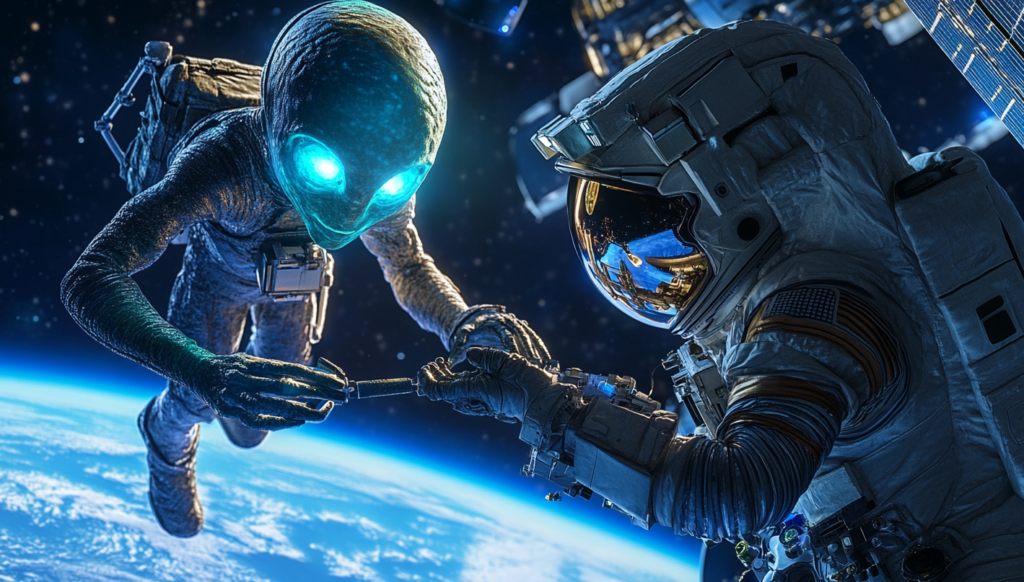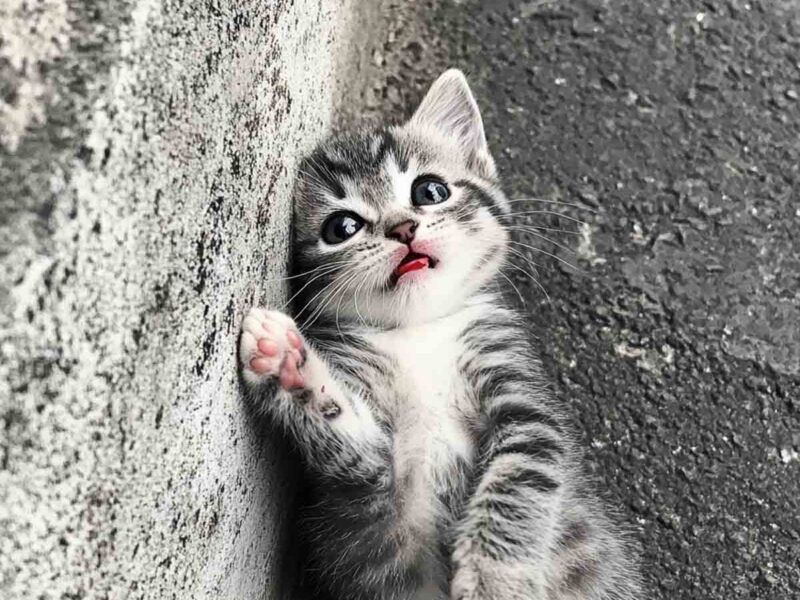Chapter 1: The Unseen Observer
The sun dipped below the horizon, casting long shadows over the quiet fields of a remote Midwestern farm. As dusk settled in, the world seemed to pause. On the outskirts of the farm, hidden among tall blades of wheat, lay a camera—small, unassuming, and perfectly positioned to capture the daily life of this secluded countryside. Installed by a wildlife enthusiast hoping to document the movement of deer and foxes, the camera recorded day and night, never tiring, never blinking.

What it captured was beyond anything its owner had ever imagined. The first few frames seemed ordinary: a breeze rustling through the wheat, a hawk gliding silently overhead. Then, as the night deepened and the stars blanketed the sky, something changed. The lens caught a flicker of movement, something small and quick, darting between the shadows. The footage later revealed a figure, slender and gray, with large, black, reflective eyes that seemed to drink in the starlight. It paused, crouched low, studying the ground with intense focus.

The next morning, when the camera owner, a retired teacher named Emily, retrieved the footage, she was puzzled. She replayed the video over and over, adjusting the brightness and contrast to get a clearer view. Could it be a prank? Some strange animal? But the more she looked, the more she realized this was unlike anything she’d ever seen. She knew she had to share it, not just with the internet, but with the world.
Chapter 2: The Viral Phenomenon
Within hours, Emily’s video spread like wildfire. News outlets picked up the story, and soon the world was buzzing with the possibility of first contact. Experts in cryptozoology, astrophysics, and even government officials chimed in, debating the footage’s authenticity and what it could mean for humanity. Forums exploded with theories, ranging from government cover-ups to aliens scouting Earth for invasion.
But Emily wasn’t interested in conspiracy theories. She had seen something in those eyes—something almost… human. And as more videos surfaced from other remote cameras around the world, it became clear that these beings weren’t here for conquest or diplomacy. They were observing, silently, perhaps even studying.

Dr. Robert Langley, a renowned scientist specializing in astrobiology, was among the first to take Emily’s footage seriously. He noticed something everyone else had missed—a subtle pattern in the alien’s movements. “They’re not random,” he told his colleagues. “They’re methodical, calculated. They’re collecting data.” With Emily’s permission, Dr. Langley set up his own camera traps, strategically positioned around known sightings. What they captured next would change everything.
Chapter 3: The Unlikely Encounter
Late one night, under a blanket of stars, a camera in a dense forest near the Canadian border recorded a scene unlike any other. A lone figure, similar to the one in Emily’s footage, emerged from the shadows. It moved with a grace that was both alien and familiar, almost like a child exploring a new world. It reached down, picked up a handful of earth, and studied it intently.

Suddenly, a faint rustling caught its attention. The alien turned sharply, its eyes locking onto the camera. For a moment, it seemed aware of being watched. It approached cautiously, its large eyes reflecting the moonlight. The being stretched out a thin, elongated hand, almost as if trying to understand the device before it. Then, as quickly as it had appeared, it vanished back into the darkness, leaving behind a sense of wonder and a million new questions.
When Dr. Langley reviewed this footage, he felt a chill run down his spine. He could see curiosity in the alien’s movements, but also fear—fear of being discovered. “They’re not just watching us,” he said in a press conference. “They’re trying to understand us.”
Chapter 4: The Discovery
Over the following months, sightings increased. Farmers, hikers, and even children playing in their backyards reported glimpses of the mysterious beings. Each account seemed to echo the same sentiment: these beings were peaceful, almost timid, yet incredibly intelligent. They were seen harvesting plants, examining rocks, and interacting with Earth’s natural elements in ways that suggested a profound curiosity.

The scientific community was divided. Some believed the aliens were simply tourists, travelers from a distant world seeking to learn about a new planet. Others, like Dr. Langley, believed there was something more. “These beings have traveled light-years, crossing the vast expanse of space,” he argued. “They didn’t come here by accident. They’re here with a purpose.”
Then, a breakthrough came from an unexpected place. In a small village in South America, a farmer named Juan stumbled upon a peculiar device left behind by one of these beings. It was a small, metallic cube, covered in strange, intricate symbols. When touched, it emitted a soft hum, vibrating gently in Juan’s hand. Scientists flocked to the site, analyzing the object with every tool at their disposal. It wasn’t a weapon or a tool of communication. It was something more profound—an instrument for learning, perhaps even for teaching.

Chapter 5: The Message
Dr. Langley and his team worked tirelessly to decode the symbols on the cube. Weeks turned into months, and just when they were about to give up, they made a startling discovery. The symbols were mathematical in nature, a universal language. Through a series of calculations and patterns, they revealed a sequence—coordinates, a map of sorts. But to where?
The coordinates pointed to a remote region in the Arctic, a place untouched by modern civilization. Armed with this knowledge, Dr. Langley organized an expedition. Along with a small team of scientists, they journeyed to the desolate tundra, braving the harsh conditions in search of answers.

What they found was nothing short of extraordinary. Beneath the ice, buried deep within a cave, lay a structure. It was ancient, but clearly not of this Earth. The walls were covered in the same symbols as the cube, glowing faintly as if alive. As they ventured deeper, they came upon a chamber with a central console, much like the one Juan had found.
When they placed the cube on the console, the room lit up. A holographic image emerged, depicting the solar system, with Earth at its center. And then, a voice—soft, melodic, and undeniably alien—spoke. It wasn’t a language they could understand, but it was clear. This was a message. A message of unity, of curiosity, and above all, of peace.
Chapter 6: The Silent Witness
As news of the discovery spread, humanity found itself at a crossroads. For centuries, we had looked to the stars and wondered if we were alone. Now, faced with the reality of an intelligent species reaching out to us, we were forced to confront our own nature. Would we respond with fear and hostility, or with the same curiosity and openness that these beings had shown?
Dr. Langley believed it was the latter. “They’ve been watching us for years, maybe longer,” he said. “They’ve seen our wars, our conflicts, but they’ve also seen our compassion, our desire to explore, to learn. That’s why they’re here. They see in us a kindred spirit, a species capable of growth.”

As for Emily, she continued to watch the fields, her camera now a symbol of the bridge between two worlds. She had never imagined that her simple desire to capture the beauty of nature would lead to humanity’s first encounter with the unknown. But as she looked out over the golden wheat swaying in the breeze, she couldn’t help but feel a sense of hope.
The aliens, it seemed, were not so different from us. They were silent witnesses to our world, exploring and learning, much like we had done for centuries. And perhaps, in their eyes, they saw the potential for a friendship that spanned the stars.
Chapter 7: A New Beginning
The discovery in the Arctic changed everything. Governments began to reach out, not in secrecy, but with transparency, inviting scientists and thinkers from around the globe to collaborate. The footage from cameras like Emily’s became essential pieces in a puzzle that humanity was just beginning to understand.
Dr. Langley, Emily, and a team of global experts proposed a daring idea: an invitation. Using the symbols and language learned from the cube, they crafted a message, a call for dialogue and understanding. It was broadcasted on all frequencies, sent out into the vastness of space.

Months passed with no reply. Many began to lose hope, believing that the aliens had already learned enough about humanity and moved on. But Emily remained steadfast, her faith unwavering. “They’ve been patient with us,” she said in an interview. “We need to show them the same patience.”
Then, one quiet night, as Emily reviewed her footage like she had done countless times before, something caught her eye. There, amidst the wheat, stood a familiar figure, holding a small, glowing device. The alien seemed to be waiting, almost hesitantly. Emily’s breath caught in her throat. She realized this wasn’t just another encounter. This was an answer.
And for the first time, as she watched through her camera, the alien turned directly towards her, lifted its hand, and waved.
Epilogue: The Future Unwritten
Humanity’s first encounter with extraterrestrial life was not one of grand battles or technological domination. It was a story of curiosity, of quiet observation, and ultimately, of mutual understanding. The beings from the stars had chosen to reveal themselves not to governments or militaries, but to the people, to individuals like Emily and Dr. Langley, who saw them not as invaders, but as fellow explorers in a vast universe.
As the world moved forward, it did so with a new sense of purpose. The stars were no longer distant, unreachable points of light. They were places, homes to beings just like us, who looked up at their own skies and wondered, “Are we alone?”
The answer, as it turned out, was more beautiful than anyone could have ever imagined.

